This is a Kodak Signet 35 rangefinder camera made by the Eastman Kodak company out of Rochester, NY, USA. This was the first in a line of several Signet models that would be sold in the 1950s and 60s. It replaced the Kodak 35 rangefinder camera which was discontinued in 1951. Widely considered to be one of the best looking Kodak cameras of the era, it had a compact and lightweight aluminum body, a large and bright (for the day) coincident image rangefinder, and it came with an excellent 4 element Tessar designed 44mm Ektar lens. The Signet 35 sold new for $95 meaning it was aimed at the mid to upper end of the 35mm market. A persistent rumor exists that this camera was developed for use by the US Military during the Korean war, which explains it’s oversized controls, durable and compact metal body, and excellent optics.
Film Type: 135 (35mm)
Lens: 44mm f/3.5 Kodak Ektar coated 4 elements
Focus: 2′ to Infinity
Type: Coupled Rangefinder
Shutter: Kodak Synchro 300 Shutter
Speeds: B, 1/25 – 1/300 seconds
Exposure Meter: None
Battery: None
Flash Mount: ASA Bayonet Flash Sync
Manual: http://www.cameramanuals.org/kodak_pdf/kodak_signet_35.pdf
History
Kodak was on a bit of a high after World War II. It’s Medalist cameras had played a role during the war and afterwards, sold well as a top of the line American made camera that made no compromises with quality, had one of the best lenses ever made, and had a reputation as helping to defeat the Germans. Kodak’s film business led the worldwide market, and even their entry level Kodak 35 was selling well. By the time the 1950s had started, competition from the Japanese market was very strong. There were at least a dozen Japanese manufacturers all exporting their models to the west. Germany had resumed it’s optics industry and was successful at exporting many different marques as well. For the European market, makers from Great Britain, Italy, France, the Soviet Union, and even Czechoslovakia had thrown in their hand into the camera market with competing models.
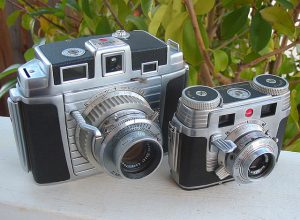
Kodak knew that they couldn’t just rest on it’s past successes, and for their next model, would need to come up with a well built camera with modern features and excellent optics. In 1951, the Kodak Signet 35 would be released with a completely new metal body that mimicked some design elements of the also new Kodak Chevron which was their top of the line medium format camera. Some other features of the Signet 35 were a coincident image rangefinder with unique triangle rangefinder patch, large controls, a bright and easy to use viewfinder, and an excellent 4 element Ektar lens. Over the course of the next few years, Kodak would release 4 other models as part of the Signet line, the Signet 30, Signet 40, Signet 50, and Signet 80. Only the Signet 35, 40, and 80 would have a rangefinder, and only the 80 would be have interchangeable lenses.
For all of the accolades that could be said about the Signet 35s design, controls, and lens, there was one glaring downside to the camera, which was it’s shutter. Many articles have been written questioning Kodak’s decision to come up with a nicely designed modern camera with an excellent lens, and stick it with a very basic 2-blade 4 speed shutter incapable of anything slower than 1/25 second or faster than 1/300 second. Typical 1950s leaf shutter cameras could usually go down to a full second all the way up to 1/500 second, and focal plane shutters commonly went to 1/1000 second, so why was the Signet limited to only 4 speeds?
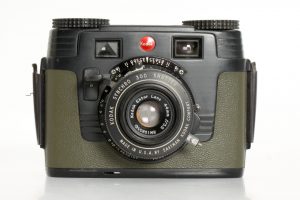
One theory is that Kodak built this camera with the US Military in mind. Such a camera would favor reliability over faster speeds, and would be serviceable in the field. Whether this is true or not, there’s at least some truth to it because all black and black/olive variants exist that were designed for the US Army and Air Force. Plus, it would make sense for the military to have a need for a compact camera with large controls that could be used while wearing gloves, and an excellent lens that would allow for highly detailed enlargements.
Regardless of the reason, the Signet 35 was perceived in the market as a nice camera with an excellent lens, but a poor shutter. While I was not able to find any information about production numbers, it was only made for just over 7 years, and when it was discontinued, there was no clear replacement in Kodak’s lineup. While 7 years might not seem like a short amount of time, to put it into perspective, the Kodak 35, which was the model prior to the Signet 35, was designed to compete with the Argus C3 from 1938. The C3 would outlast both the Kodak 35 and Signet 35 and still be in production for another 8 years after the Signet 35’s discontinuation in 1958, lasting a total of 28 years.
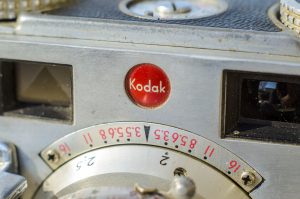
Back when this camera was new, anyone considering buying a Signet 35 would have used this as their primary camera, and for them, the limited shutter speeds may have limited the situations in which the camera could be used. But today, a vintage photographer like myself is used to working with these types of limitations. If I need a camera for flexible lighting situations with a precise shutter, I have many better options, but if I want to try out this camera, I can load in some ISO 100 or 200 film and shoot outdoors using the Sunny 16 rule.
I truly believe that the shutter is less of a con today than it was back when this camera was new. Shooting with a Signet 35 using slow color film indoors without a flash would have been extremely difficult. Today, film is much faster and better suited to the shutter speeds that the Signet does have. And let’s not forget that lens. The Kodak Ektar label was reserved for Kodak’s top of the line lenses. Only the Kodak Medalist, Chevron, and other high end cameras ever had a lens with the Ektar label. It’s worth noting that although the Ektar in the Signet is a completely different 4 element design than the 5 element Ektar found in the Medalist, it’s still a very good lens.
Repairs
The weakness of the Signet 35’s shutter is well known, and like many mid century shutters, is prone to become sticky over the course of decades. Thankfully, mine observed no such behavior. In fact, the camera was in perfect working order other than the usual tarnished metal body and a dirty viewfinder.
One thing that I initially thought was an issue, but later turned out not to be is that for some reason, it was very difficult to fire the shutter without any film in the camera. I could fire it, but I had to press down on the shutter really hard. At first, I thought it was that something might be bent, but after loading some film into the camera, I noticed that the resistance in the shutter release was gone. I cannot explain why it would be any different, and I don’t even know if this is normal, so it might still be a sign of a future problem with this camera, but while shooting the first roll through this camera, I never experienced the difficult shutter release like I did before the film was put into the camera.
I decided against trying to polish the body of the camera as I learned when I restored my Mercury II rangefinder, that once you start restoring a body, it always gets to be more complicated than you first realized, but I did have to do something about the dirty viewfinder.
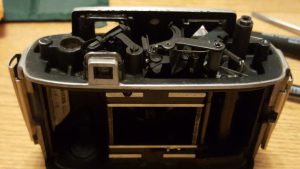
Thankfully, removing the top plate of the Signet 35 is very easy. You only have to remove the large screws in the center of the rewind and advance knobs, and then remove the two screws that are beneath each of the knobs. Once all 4 screws are out, the top plate comes off and you can clean the viewfinder. As always, be very careful when working near the beamsplitter, which is that diagonal piece of glass. It has a very delicate surface that can be easily rubbed off if you are not careful.
Mike Elek has some good information and pictures showing how to remove the top plate and also how to adjust the rangefinder for vertical or horizontal corrections.
My Kodak Signet 35 needed no other work to be done, so I put everything back together, wiped down the body and film compartment and loaded in my first roll of film and went shooting!
The Signet is a camera with two faces. One face is that of a very nicely built camera with an excellent lens and a good looking metal body with large and easy to use controls. The other face is one with 2 pretty significant “cons”. The Signet 35 replaced and improved upon the Kodak 35 when it was discontinued in 1951. Despite the many improvements to the design and controls of the older Kodak, the Signet lost the ability to automatically cock the shutter when advancing the film. The outgoing Kodak 35 (even the original model from 1938) would automatically cock the shutter for the next exposure upon advancing the film to the next frame. With the Signet 35, cocking the shutter is a separate process like on the Argus C3 or any number of other low end cameras where you have to push down on a lever protruding out of the shutter. Perhaps Kodak couldn’t come up with a method that was reliable enough for military use, or maybe they just did it to cut costs, but I’ve never been able to find a clear reason.
The other “con” is more a side effect of the small size of the camera which is how easy it is to block the rangefinder window with your hand while holding the camera. I found that while shooting with this camera, I would momentarily forget to focus the camera because I couldn’t see the triangle rangefinder patch due to my hand blocking the window. This is something that can happen on other cameras such as the Contax/Kiev cameras, and you just have to remember to hold your hand in a slightly modified position when composing and focusing your shot.
Coincident image rangefinders were still pretty new in the early 1950s when this camera came out, so combined with the excellent Ektar lens and solid metal body, this camera may have appeared to be a pretty high end model, but it’s basic shutter and inability to automatically cock the shutter most likely confused consumers and led to poor sales. The Signet 35 sold for $95 in 1951, which is comparable to something costing over $850 today, so I suspect that people looking to spend close to $1000 in 1951 might have looked elsewhere. Remember that by this time, the Japanese were already flooding the market with well built and inexpensive models, and Germany had resumed camera operations, so there was a plethora of excellent cameras to choose from at every price point.
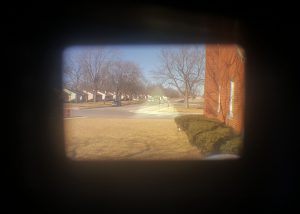
If you can look past the shutter and don’t mind the easy to block viewfinder, you’ll find that this camera is really quite nice to use, especially with today’s films. The Signet 35 fits easily into a pocket and is comfortable to hold. The large knobs and large shutter release are easy to find quickly. The triangular rangefinder patch is large and easy to see, and if you clean the viewfinder and can get it bright and free of debris, it is very easy to get accurate focus. If the rangefinder needs adjustment, the top plate is easy to remove and get to the adjustment screws.
The Signet 35 generally has pretty positive reviews from others who have shot one. Most people seem to like the small size of the camera and the Ektar lens. The most common complaints are in the shutter itself, and the sometimes dark viewfinder. I am lucky to have an example with a good viewfinder that’s easy to use. It’s certainly not as nice as more modern rangefinders like the Yashica Electro or Canonet QL17, but it works well enough.
As for the limited shutter speeds, if your plan is to take the Signet 35 outdoors and shoot Sunny 16, you really only need one or two shutter speeds. If you’re shooting color, you are probably best with 100 speed film and then you can set your shutter to 1/100 and leave it there all day. You could use 200 and 400 speed film and just leave it at 1/300, but this being a 60 year old camera, there is no guarantee the speeds are even accurate, so there is a chance that you’ll overexpose fast film like 400 speed. If you shoot B&W, probably any speed would work. The greater latitude of B&W will adapt well to the Signet’s limited shutter speeds.
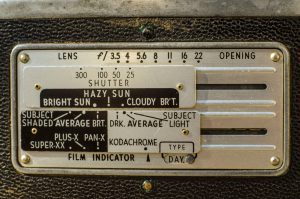
I mention earlier in this review that the limited speeds are probably less of an issue today than they used to be when this camera was new, because no one is going to use a Signet 35 as their every day camera. It works fine with modern “fast” films, as long as you stay within the limits of the camera. This isn’t something I would take on a vacation where I would have unpredictable lighting conditions that require a flexible camera. There are certainly many other cameras much better suited for situations like that. But if you’re going on an outdoor adventure where the lighting will be mostly predictable, you’ll be fine as long as you pair the Signet 35 with the right film.
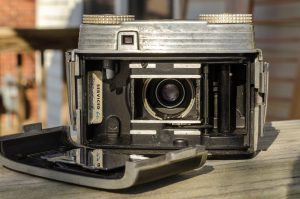
Loading film into the camera is easy as the entire back of the camera is removable with a single latch on the right side. Unlike other removable back cameras, the back is separate from the bottom of the camera. After removing the back, the camera can still sit on a table without falling over unlike many Soviet rangefinders. The film pressure plate is also unlike most other cameras, in that its a polished metal with a mirror-like shine to it. I recall reading on some other sites that say this mirror finish can actually cause problems with high speed slide film as light can reflect off the pressure plate and hit the film twice. The channels around the edges of the film compartment are painted black and very deep, so there is no foam or yarn material needed to keep light out.
One last thing that I observed with my Signet is that the shutter doesn’t fire easily if film is not in the camera. I am not sure if this is by design, or if there is something different about my camera. I found that by manually cocking the lens and pressing the shutter release, there was some resistance in the shutter release. I would have to press down very hard on the shutter release to get it to fire. I assumed that was just how it was, until I actually loaded film into the camera. Looking at the camera again now that it is empty, I cannot really see why this is true. There doesn’t seem to be anything that the film controls which would set tension on the shutter release, so this is why I think there is a chance this is unique to mine. Perhaps someone reading this review can comment whether this is true about theirs. The good news is that once film is in the camera, the shutter releases very easily. All thats required is smooth pressure on the large shutter release button and it will click as expected.
My Results
I took my Signet 35 along with 5 other cameras on a trip into Chicago one Saturday in February, and along with it were two other rangefinders, a Canon P, and a Kodak Retina IIc. This being the most basic of the three, I expected to like it the least, but as I got to using it, I found that this camera’s use belies its specs. While it’s obvious that this is a small camera, what you don’t really consider until you are actually using it is how compact it is. While walking around the Chicago Loop, I found the Signet to be very easy to slip in and out of my pocket. While the Retina is even more compact when it is folded up, you have to take the time to unfold it before each use. While I won’t say that its hard to unfold a Retina, it is just one more step before and after taking a photo that you don’t have to monkey around with on the Signet. The large knobs and shutter release are extremely easy to locate for spontaneous quick shots.
In terms of viewfinder size and brightness, both the Signet and Retinas are actually very similar. The Canon P definitely wins with the largest and brightest viewfinder, but it is also the largest of the 3 cameras I was shooting with that day. But how did it perform?
Before I comment on the results below, I should state that in hindsight, I didn’t make the best choice for film. I shot with expired Kodak Gold 200 from the early 1990s on a mechanical camera that I had never used before. While many of the outdoor shots came out fine, almost every low light shot came out very grainy and extremely underexposed. The rule of 1 stop for every decade past film’s expiration date was definitely valid here and therefore, I wont share any of the low light shots that came out poorly even though they were properly focused.
I am really quite pleased with these shots. Every single one of them was in focus which tells me the rangefinder is accurate. This is especially important considering many of the reviews I’ve read from other users state that the Signet 35’s rangefinder isn’t the easiest to use. I can say that I had no problems with the triangle patch in the viewfinder.
Comparing the Canon 7 and Kodak Retina IIc that I was shooting with in Chicago, the Canon 7’s viewfinder is the largest and brightest I’ve ever used, so there is no comparison there, but compared to the Retina (which was considered to be the superior camera of it’s day), think I actually prefer the Signet 35’s viewfinder better. For one, its a little brighter for me and the triangle patch was just easier for me to use.
The Ektar lens is very good. I know that in Kodak’s product lineup, the Ektar lens was their top dog lens, but since this shoots 35mm film, I would say this is on the level with the Anastigmat Special or Anastar lenses of the time. I speculate that you really need to move up to medium format to really see the difference between an Ektar and the next step down in Kodak’s lineup. I cannot see any sharpness differences between this lens and the Anastigmat Special of the Kodak 35, but that’s not a bad thing, because both lenses are really nice.
After using the Signet 35, I have a lot more respect for it. This camera is clearly working properly, there were no light leaks, every shot came out properly focused, and the images were sharp. Next time I take this camera out, I will be sure to give it fresh film to really see what kind of colors I can get from that Ektar lens. I think it says something that I shot this camera side by side with a Canon P, which is superior in every way to the Kodak, yet I still came away feeling impressed with the Signet 35. I think it is interesting that of the 3 cameras I had that day, I feel as though the Retina was the only one I walked away feeling indifferent about. That is not so much an insult to the Retina, but more of a huge compliment to how wonderful the Signet 35 really is.
If you’ve made it this far into this review wondering if you should pick up a Signet 35 for yourself, the answer is a resounding yes! Don’t let anyone tell you that it’s simple 4 speed shutter is a detriment to this camera, because it’s not. Even if the rangefinder wasn’t as easy to use and even if the lens wasn’t quite as sharp, it would still win you over with it’s good looks, over sized controls, and compact body.
My Final WordHow these ratings work |
The Signet 35 is one of the few cameras that could possibly be better now than it was when it was new. It is a good looking camera that has a very unique balance of compact size, yet large and easy to use controls. Although it is limited on shutter speeds, the razor sharp lens and easy to use viewfinder more than make up for it. This is a camera you can easily throw in a handbag or even your coat pocket and fire off a few spontaneous shots with ease. Shoot this camera with some 100 or 200 speed film and use Sunny 16 and there is no reason you couldn’t shoot an entire roll of perfect exposures. | ||||||
| Images | Handling | Features | Viewfinder | Feel & Beauty | History | Age | |
| 2 | 2 | 1 | 1 | 2 | 0 | 30% | |
| Bonus | None | ||||||
| Final Score | 10.4 | ||||||
Additional Resources
http://camerapedia.wikia.com/wiki/Kodak_Signet_35
http://camera-wiki.org/wiki/Kodak_Signet_35
http://pheugo.com/cameras/index.php?page=signet35
http://jasonepowell.com/essays/camera-shoot-out-argus-c-four-vs-kodak-signet-35/
http://elekm.net/pages/cameras/signet35.htm
http://www.deansphotographica.com/deans_of_idaho/old_stuff_pages/signet35/signet35.html
http://www.alexluyckx.com/blog/2015/09/ccr-review-18-kodak-signet-35/

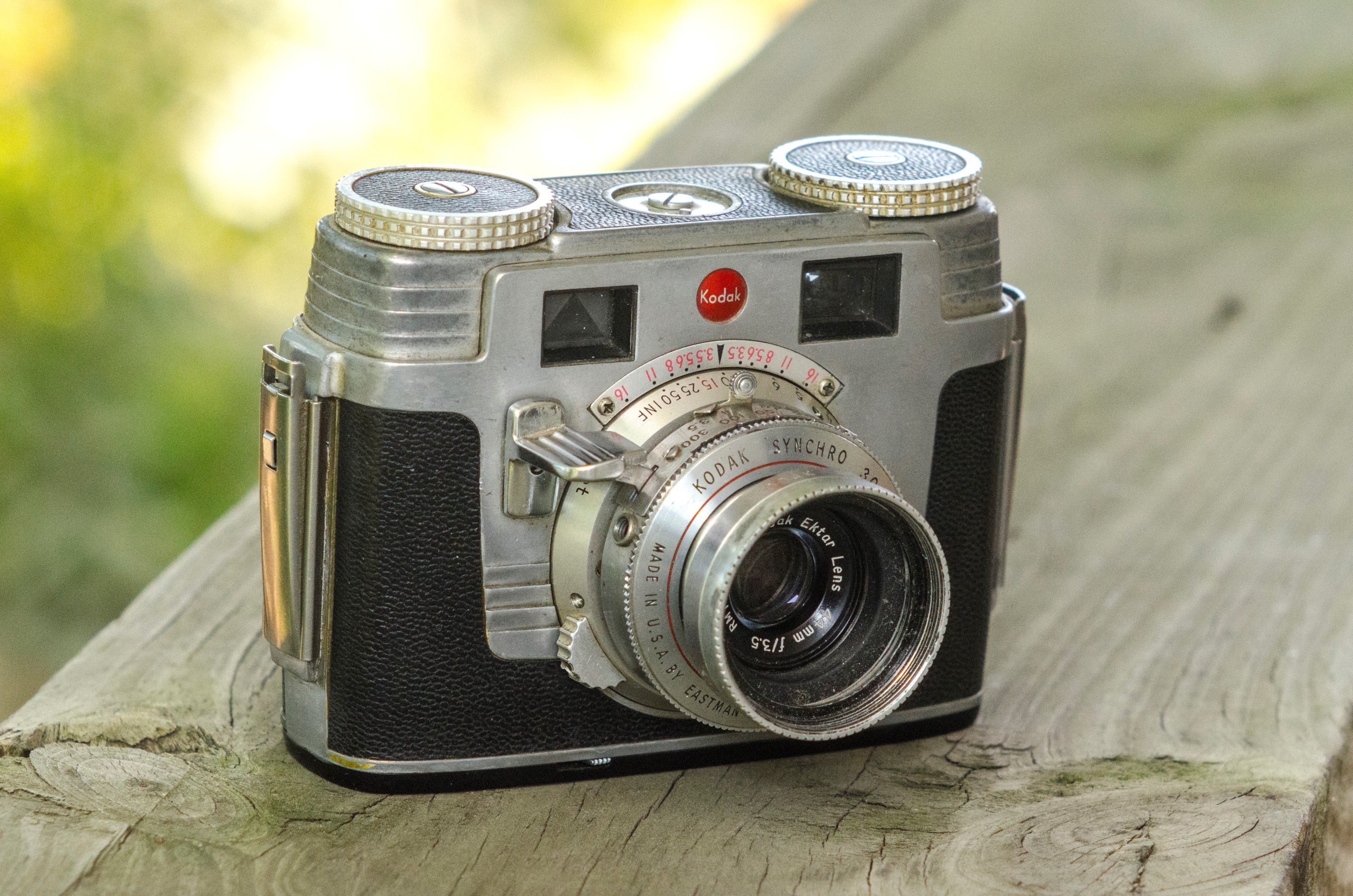
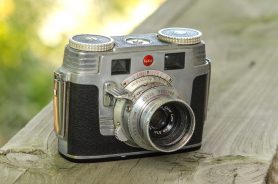
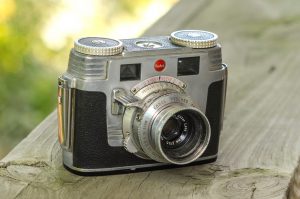
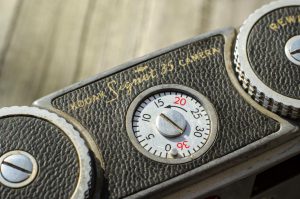








Outstanding write up of an often overlooked or underappreciated camera! This certainly represents an interesting era for Kodak in trying to reach a bit of a middle-tier market while facing increasingly tough competition from aboard. It seems that while there is room to malign this camera, it is still quite durable and fun to shoot, as you’ve proven, and the speeds line up quite well with typical film speeds of today!
You are quite right, is camera was designed for the military. The images of these cameras were not going to be in the Saturday evening post however. Remember that in Battalion size units and lower, the unit photographer was an additional duty assignment. I assigned a buck sergeant to the unit photographer position in one of the units that I commanded and it came down to whether he really wanted to shoot with a camera or not, and not weather he was qualified to. Also remember that these cameras were designed for Kodachrome film and the images taken with these cameras were very specific to the battlefield. You probably noticed a couple of interesting things about this camera like the back of the camera completely came off. This was because if the camera door were opened up with a hinge like on most 35mm cameras and the private dropped the camera on the ground it would break the back of the door off and be useless. The other thing of note is that the serial number for the camera is underneath the dial on the left hand side and not on the inside of the camera. This was because when the soldier brought the camera back to the unit armor he didn’t have to take the camera apart and ruin what film was in there to read the serial number off of it. The images taken on these types of cameras were of Battlefield conditions. Possibly injuries, collateral damage, pre battle conditions, and anything unit commanders wanted photographs of to record the battle. None of these photographs were ever seen by anyone outside of the unit as they were all classified. These images went from the soldier to the unit photography section and on a need-to-know basis. To be honest your sun is either going to be bright hazy or cloudy. Your subject is either going to be bright medium or dark. You really only need one or two shutter speeds to take a good image of anything no matter what the professionals tell you. The military knew that and so did Kodak. Sunny 16 is out there, well because, it’s the Sunday 16 rule. 90% of the images taken with any camera will always be within 1
or 2 Stops either way of the sunny 16 rule, On the battlefield. Kodak gave the military a really good camera. It was built like a tank, it could take abuse, the soldier could stick it in his field jacket pocket without breaking any of the knobs off of it. Above all plastic freezes and brakes in cold-weather, aluminum doesn’t.
This is all very fascinating stuff Bill. I only know of basic information regarding the military’s use of these cameras, but getting any specifics like you shared is difficult, so thank you. I agree that the perceived “limitations” of the Signet 35 aren’t really that limiting at all. Even today with modern 100 and 200 speed film, this camera is very usable with Sunny 16. My only regret is in the nearly 2 years since I posted this review, I have not shot a second roll through my Signet. I need to change that.
I have several of these cameras, and like them a lot. One does, however, have to be willing to work within the camera’s limitations.
The Signet 35 has double exposure prevention, which is released when the film sprocket inside the camera is turned. This is why you found it difficult to fire the shutter without film in the camera. (Forcing it could in theory damage the shutter.) The camera does, however have multiple exposure capability, which can also be used to “dry fire” the shutter. When facing the front of the camera, with the lens looking at you, there is a sliding, serrated tab right next to the bottom of the camera, about 1/3 of the way from the left hand side (just under the left side of the lens). This tab can be used to release the double exposure prevention lock, allowing double exposures, or dry firing of the shutter, whichever the case may be.
Jim
Thanks for this really useful write up on a fascinating camera! A good friend of mine gifted me one and I have shot one roll with it – ironically a fascinating expired roll of Kodak Panatomic X – and the shots came out pretty well. I have been reluctant to shoot another roll primarily because of the exact issue you raise around triggering the shutter without film! I’m happy to read James’ explanation above; time to get some film in that camera!
My viewfinder however is *very* hazy making focusing with it virtually impossible. I don’t know if I’m brave enough to take the top off and clean it. I might shoot a couple of rolls of film before deciding to go there.
Thanks again for the excellent article!
My first “real camera” was Dad’s Signet 35 which I “inherited” when he moved to a Nikon F in about 1968. He had already taught me darkroom work, so I put as many frames through it as my minimum-wage after-school jobs would let me afford PlusX or TriX, Microdol, and paper. By the time I got my Nikkormat in 1975, that Signet had taught me the basics….I kept it, and a couple of years ago started using it again. Everything you said about pleasure to use rings true. Only problem I’ve head is some difficulty in re-calibrating the focus mechanism after I partially disassembled it for a good cleaning. (Dad’s F is now my F….another treat of a camera in use).
Excellent review illustrated with wonderful photos! The more we can do to keep older cameras alive and kicking, the more vibrant we can keep the body of the world’s portfolio of photographic output. I own and use several Signet 35s, and I find them very agreeable. I also have successfully removed the great 44mm Ektar lenses from a few junker bodies which were otherwise unsalvageable. These lenses work very well on mirrorless digital cameras like the Sony Nex series.
I do have one small nit to pick with your review, where you describe the Ektar lens as Kodak’s “top dog.” This is very true, especially in the case of the 100mm f/3.5 Ektar from the Medalist, which is a brilliant interpretation of the Heliar-type design. And certainly comparing the Signet 44mm Ektar to the Kodak 35’s Anastigmat Special is perfectly appropriate. You are comparing a 4-element Tessar design to a 4-element Tessar design. However, you really can’t compare the Signet 35’s lens head-to-head with the Retina II(c)’s 50mm f/2 Schneider Retina-Xenon (or Rodenstock Retina-Heligon) which is a 6-element Gauss design, a much faster, sharper lens by design.
Just a minor point, keep up the good work!
Mike — to answer your question — the difficulty pushing down on the shutter release is probably only on your example — I have four of these things (1 civilian, 3 military) and they all fire very easily with no film, just using the front lever to release the shutter.
Fun little cameras.
Thanks for a great article. Over time I have acquired a few of these little aluminum jewels. Some observations, the shutter does become stiff without film. I think there may be a linkage with the film sprocket. You can test this by hand advancing the sprocket, cocking and then releasing the shutter. The bodies I have found with the polished pressure plates are only on the early models. Later models all seem to have black pressure plates. Finally, the date code is on the lens as a two letter sequence. This corresponds to the Kodak word, “CAMEROSITY“ with the digits 1 to 0 relating to each letter. I was searching for the code”RM” the year of my birth. Thanks again for your invaluable information.
$95.00 in 1951= $1,185.00 in 2025, love this camera. Precision built!